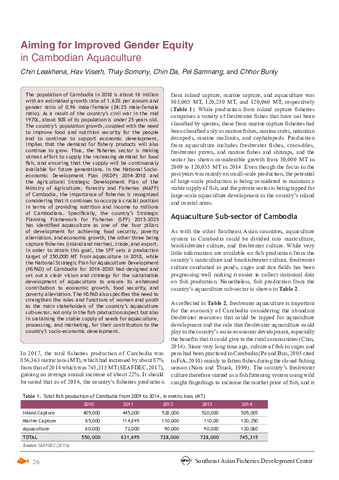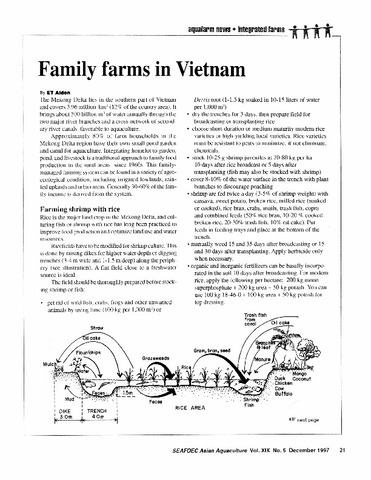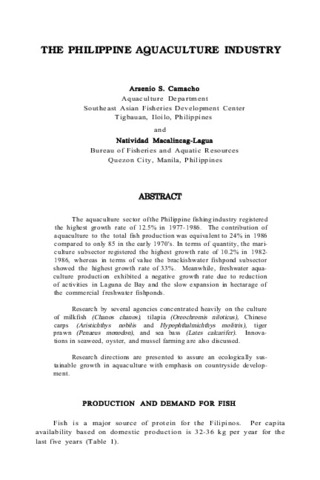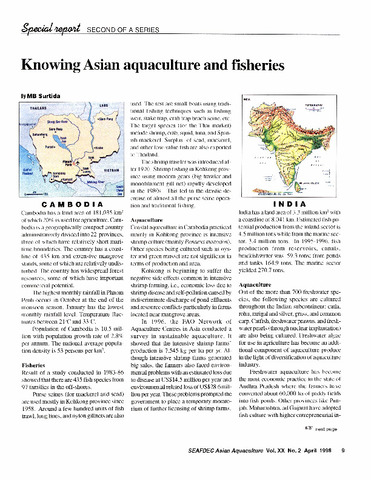Perlihatkan publikasi sederhana
Aiming for improved gender equity in Cambodian aquaculture
Share
| dc.contributor.author | Leakhena, Chin | |
| dc.contributor.author | Viseth, Hav | |
| dc.contributor.author | Somony, Thay | |
| dc.contributor.author | Da, Chin | |
| dc.contributor.author | Samnang, Pel | |
| dc.contributor.author | Bunly, Chhor | |
| dc.date.accessioned | 2018-08-15T05:59:35Z | |
| dc.date.available | 2018-08-15T05:59:35Z | |
| dc.date.issued | 2018 | |
| dc.identifier.citation | Leakhena, C., Viseth, H., Somony, T., Da, C., Samnang, P., & Bunly, C. (2018). Aiming for improved gender equity in Cambodian aquaculture. Fish for the People, 16(2), 26-32. | en |
| dc.identifier.issn | 1685-6546 | |
| dc.identifier.uri | http://hdl.handle.net/20.500.12066/1379 | |
| dc.description.abstract | The population of Cambodia in 2018 is about 16 million with an estimated growth rate of 1.63% per annum and gender ratio of 0.96 male/female (24:25 male:female ratio). As a result of the country’s civil war in the mid 1970s, about 50% of its population is under 25 years old. The country’s population growth, coupled with the need to improve food and nutrition security for the people and to continue to support economic development, implies that the demand for fishery products will also continue to grow. Thus, the fisheries sector is making utmost effort to supply the increasing demand for food fish, and ensuring that the supply will be continuously available for future generations. In the National Socioeconomic Development Plan (NSDP) 2014-2018 and the Agricultural Strategic Development Plan of the Ministry of Agriculture, Forestry and Fisheries (MAFF) of Cambodia, the importance of fisheries is recognized considering that it continues to occupy a crucial position in terms of providing nutrition and income to millions of Cambodians. Specifically, the country’s Strategic Planning Framework for Fisheries (SPF) 2015-2025 has identified aquaculture as one of the four pillars of development for achieving food security, poverty alleviation, and economic growth, the other three being capture fisheries (inland and marine), trade, and export. In order to attain this goal, the SPF sets a production target of 250,000 MT from aquaculture in 2018, while the National Strategic Plan for Aquaculture Development (NSPAD) of Cambodia for 2016-2030 had designed and set out a clear vision and strategy for the sustainable development of aquaculture to ensure its enhanced contribution to economic growth, food security, and poverty alleviation. The NSPAD also specifies the need to strengthen the roles and functions of women and youth as the main stakeholders of the country’s aquaculture sub-sector, not only in the fish production aspect but also in sustaining the stable supply of seeds for aquaculture, processing, and marketing, for their contribution to the country’s socio-economic development. | en |
| dc.language.iso | en | en |
| dc.publisher | Secretariat, Southeast Asian Fisheries Development Center | en |
| dc.subject | Cambodia | en |
| dc.subject | South East Asia | en |
| dc.title | Aiming for improved gender equity in Cambodian aquaculture | en |
| dc.type | magazineArticle | en |
| dc.citation.volume | 16 | |
| dc.citation.issue | 2 | |
| dc.citation.spage | 26 | |
| dc.citation.epage | 32 | |
| dc.citation.journalTitle | Fish for the People | en |
| dc.subject.asfa | fish | en |
| dc.subject.asfa | marketing | en |
| dc.subject.asfa | food security | en |
| dc.subject.asfa | aquaculture development | en |
| dc.subject.asfa | food fish | en |
| dc.subject.asfa | socioeconomic aspects | en |
| dc.subject.asfa | aquaculture | en |
| dc.subject.asfa | Poverty alleviation | en |
| dc.subject.asfa | growth rate | en |
| dc.subject.asfa | males | en |
| dc.subject.asfa | fishery products | en |
| dc.subject.asfa | trade | en |
| dc.subject.asfa | sustainable development | en |
| dc.subject.asfa | countries | en |
| dc.subject.asfa | fisheries | en |
| dc.subject.asfa | females | en |
| dc.subject.asfa | gender | en |
| dc.subject.asfa | economics | en |
| dc.subject.asfa | nutrition | en |




